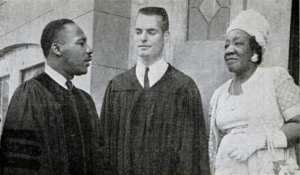Henry Elkins facts for kids
Quick facts for kids
Henry Elkins
|
|
|---|---|

Martin Luther King Jr. (left), Elkins (center), and Alberta Williams King (right) at Ebenezer, 1962
|
|
| Born | February 13, 1937 |
| Education | Yale University (BA) Southeastern Baptist Theological Seminary (BDiv) University of Chicago (PhD) |
Henry G. Elkins Jr. (born February 13, 1937), also known as Hank Elkins, is famous for his important work in the Civil Rights Movement. This movement fought for equal rights for all people. In the early 1960s, Elkins worked closely with Martin Luther King Jr.. He was an assistant pastor at Ebenezer Baptist Church. He even lived with the King family and helped lead many civil rights actions. Later, Elkins changed his career. He became an expert in public health and helping countries develop. He worked at Columbia University and with groups like the Population Council.
Contents
Education and Learning
Hank Elkins went to some great schools. He graduated from Yale University in 1959. There he earned a degree in History. In 1962, he studied divinity at Southeast Seminary. Later, Elkins decided to change his focus. He earned a PhD in Sociology from the University of Chicago in 1972.
Working for Civil Rights
In the early 1960s, Elkins was very active in the Civil Rights Movement. He worked closely with Martin Luther King Jr.. Elkins was Dr. King's Assistant Pastor at the Ebenezer Baptist Church in Atlanta in 1962. During this time, he lived with the King family.
The Albany Movement
Elkins lived and worked with Dr. King during the Albany Movement. This was an early part of the civil rights era. Dr. King's own story and other books talk about Elkins visiting King in the Albany Jail. He brought King reading materials and told him about ongoing protests.
After King was released, people were disappointed. They felt the city had not kept its promises about integration. Integration meant allowing people of all races to use the same places. The Albany Police Chief, Laurie Pritchett, closed parks that were only for white people. He did this to stop integration.
In response, Reverend Elkins (who was white) teamed up with Reverend Joseph Smith (who was Black). They also worked with lawyer William Kunstler. They led a group of both Black and white people to Carver Park. This park was only for Black people. They went there to swim and play tennis. Police Chief Pritchett then closed Carver Park too. This showed that he treated Black-only and white-only places the same way.
Protests in North Carolina
In 1963, after working at Ebenezer Baptist Church, Elkins moved. He became the director of the United Christian Campus Ministry. This was at North Carolina College, which is now North Carolina Central University. This school is a historically black college. He also directed the school's branch of the United Southern Christian Fellowship Foundation. There, he helped lead peaceful protests. These included "sit-ins" at places in the Raleigh-Durham area that were only for white people.
Later Career: Helping People Worldwide
After his civil rights and church work, Reverend Elkins went back to school. He studied Sociology at the University of Chicago. He worked with a researcher named Donald J. Bogue. They published papers together.
Later, Dr. Elkins became a research scientist at Columbia University. He worked in the Department of Public Health. He then moved to the Population Council and later to Management Sciences for Health. He became an expert in public health. He helped people in many developing countries around the world.

